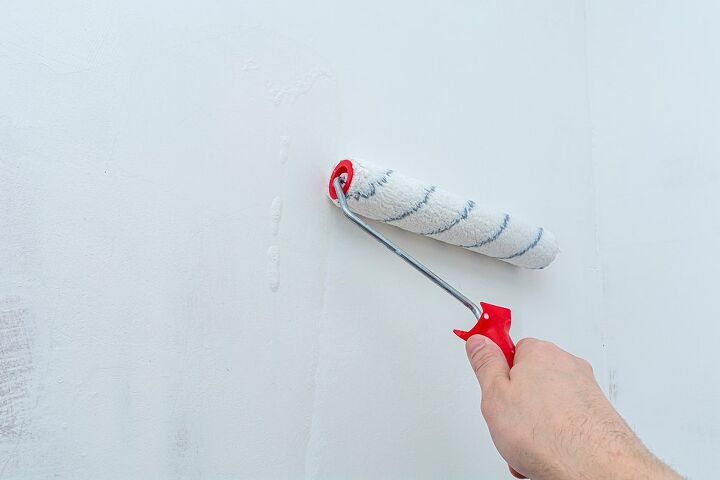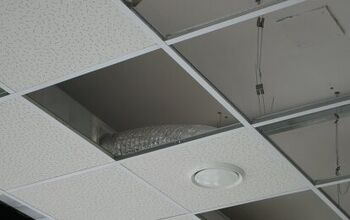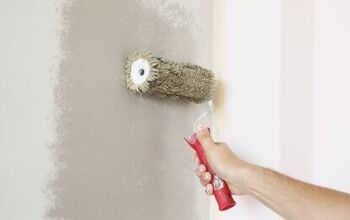My Painter Did a Bad Job! (Here's What You Can Do)

A fresh coat of paint or new color transforms a space. Hiring a painter makes the job easier, and you feel confident that the finished product will look amazing. But what do you do when a painter does a bad job?
Mark problems with painter’s tape. Contact the painter for a walkthrough. Ask the painter to fix the problems, or give you a discount. Fix the issues yourself. Linseed oil works for drips, and baking soda for cleaning up hardware and baseboards. Remedy uneven color with another coat of paint. Use a small brush to even out ceiling lines.
Fix a bad paint job by working with the painter first. If this doesn’t work, there are some easy DIY ways to take care of problem areas.
Do You Need to Hire a Paint Contractor?
Get free, zero-commitment quotes from pro contractors near you.

What to Do When a Painter Does a Bad Job
The first thing to do when you realize that you have a bad paint job is to work with the painter. If a team of painters did the work, work with the lead painter or owner of the company. Examine every part of the paint job, and mark problems with painter’s tape. It stands out. Also, make a list and take photos. Schedule a walkthrough appointment with the painter, and point out each area. Explain how you want the problem fixed.
The painter has three choices. Fix the problems at no additional charge, give you a discount, or leave the job as is.
A good painter will agree to fix the problems. Watch as the work is being done, and do a final walkthrough. This is where your list and photos come in handy.
If the painter gives you a discount, use the money to have someone fix the issues, or you can do the work yourself.
If the painter decides to leave the job as is, you can pursue the matter through the legal system if you wish. In the meantime, you have walls that need some attention.
5 DIY Fixes for a Bad Paint Job
The most common issues with professional paint jobs are:
- Drips
- Paint on hardware and baseboards
- Old color and stains show through
- Uneven ceiling lines
- Surface flaws
Drips
Drips can be fixed with linseed oil. It works for new and old drips in paint. Bring the linseed oil to a boil. Put on heat-resistant gloves, and dip a clean, lint-free cloth in the oil. Hold the cloth on the drip for about 2 to 3 minutes. This softens the paint. Put a plastic putty knife flat against the wall at the bottom of the drip, and gently push upwards. Work on the paint drip little by little rather than trying to remove it at once. Apply more of the linseed oil as needed to soften the dripped paint.
Paint on Hardware and Baseboards
Paint on hardware and baseboards can be removed with baking soda. The fastest method is to remove the hardware and soak it for 15 to 20 minutes in 1 quart of boiling water and 1/4 cup of baking soda. For hardware that cannot be removed, such as door knobs and window frames, soak a clean, lint-free cloth in the baking soda and hot water, and place it over the hardware. Leave the cloth in place for about 15 to 20 minutes. Remove any peeling paint, and repeat the process until the hardware is clean.
Old Color and Stains Show Through
If you see your old wall color or stains showing through your new paint, the painter did not prep the walls with primer. The best solution is to repaint the entire wall using a primer-based paint that is tinted to match you new wall color. Once the paint dries, check the color match with the other walls. If there is an obvious difference, paint the rest of the walls with the same primer-based paint.
Uneven Ceiling Line
Ceiling lines are tricky, even for the most experienced painters. A 2” brush that doesn’t shed works well, and the brush can be straight or angled.
Apply painter’s tape along the ceiling. Work in small 12” sections, and check the work as you go along. Put a bit of paint in a small tray, and dip the brush into the paint at a 90° angle (perpendicular to the bottom of the paint pan). You want about 1/3 of the brush loaded with paint. Tap the brush against the side of the pan to remove the excess. Don’t wipe the brush.
Make the first stroke about 2” below the ceiling line, and move the brush up to the edge of the painter’s tape. Keep the brush at a 45° angle. Slowly move the brush along the edge of the painter’s tape.
Surface Flaws
Peeling, wrinkles, blistering, blotches, and streaks are signs that the paint wasn’t applied properly. It may have been the mixing of the paint or conditions in the room when the paint was applied.
Remove peeling paint and wrinkles with a fine-grit sandpaper or scraper. Apply patching material to even out the surface of the wall, and repaint the area. Feather the paint along the edges to blend with the existing paint. Check the color match with the rest of the wall.
Blistering indicates that the room was too warm or humid, and the paint did not set right. Use a scraper or fine-grit sandpaper to remove the blisters. Apply a new coat of paint.
Fix blotches and streaks that are lighter than the rest of the wall with a fresh coat of paint. For darker blotches and streaks, use a fine-grit sandpaper to remove the excess paint. If the blotches are in a small section, paint just that area. If most of the wall has blotches, repaint the entire wall.
What If the Color Doesn’t Look Right?
We’ve all been there. You find the ideal color for your room only to have the final product look a bit strange. The painter may have used the wrong color or not mixed the paint correctly, but it may also be something else.
Colors look different under various light conditions. Natural light in your home changes through the day. In the morning, the light has a yellow color cast. Mid-day, the color cast disappears, and by the evening the light has a blue color cast.
The lighting inside your home also produces color casts. Ultra-warm and warm white lightbulbs have a yellow color cast. Cool white bulbs have a blue color cast. Natural white and daylight bulbs have no color cast.
Before you speak with the painter about using the wrong color, check the paint throughout the day to see if the issue is with the natural lighting. Also, try switching out your lightbulbs, even temporarily, to see if the paint color looks better.
Related Questions
How do I know if I will like a paint color?
A good technique to use when choosing a paint color is to use sample areas. Get small cans of the paint colors that you are considering. Paint two coats on a 3” x 3” or 4” x 4” section of the wall. If you don’t want to paint the wall, tape paint swatches on the wall. Check the color throughout the day under various lighting conditions.
What paint finish should I use?
Latex paint is available in high gloss, satin finish, and matte. High gloss paint is best for kitchens and bathrooms because it is durable and easy to clean. For high traffic rooms, such as your living room, use a satin finish. Matte is good for rooms with lower traffic, such as bedrooms.
Do You Need to Hire a Paint Contractor?
Get free, zero-commitment quotes from pro contractors near you.

What Did We Learn?
Realizing that a professional painter did a bad job is frustrating, disappointing, and heartbreaking. Mark the problems with painter’s tape. Make a log of the issues, and take photos. Schedule a time for a walkthrough with the painter. Ask the painter to fix the issues or give you a discount.
If the painter is unwilling to address the problems, there are some easy DIY fixes to common problems. Fix drips with linseed oil in boiling water. Baking soda and boiling water works for paint on your hardware and baseboards.
If you see stains or the old color showing through, a fresh coat of primer-based paint is the best solution. Tint the paint to match your new wall color.
For uneven ceiling lines, apply painter’s tape to the ceiling. Use a 2” angled or straight brush that won’t shed. Work in small 12” sections. Load 1/3 of the brush with paint, and tap the brush against the sides of the pan. Place the brush against the wall about 2” below the ceiling line. Using a long, slow stroke, move the brush to the ceiling line, and apply the paint slowly. Take your time.
Remove wrinkles, peeling paint, and blisters with soft-grit sandpaper. Apply patching material to even out the texture, followed by a fresh coat of paint.
Fix light blotches with a fresh coat of paint. For darker blotches, remove the excess paint with fine-grit sandpaper, and repaint the wall.
Make sure that your new paint looks great in your space with 5” x 5” sample patches. Check the paint color throughout the day and under various lighting conditions.

Jennifer L. Eggerton loves being hands-on, whether it's with a home DIY project, making repairs, re-decorating a room, or keeping life organized. She enjoys helping people by sharing her knowledge, insights, and experiences, as well as her lessons learned. In addition to her work as a writer, Jennifer is a Jeep® overlander, self-published author, and nature photographer who loves being outdoors.
More by Jennifer Eggerton



























